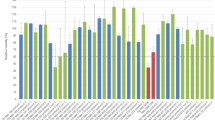Abstract
In this paper, we describe the development and application of a simple microfluidic device for in vitro irritation tests of cosmetics. The device was fabricated with a three-compartment diffusion system to mimic a hen’s egg test-chorioallantoic membrane (HET-CAM) system. Human umbilical vein endothelial cells were cultured in the three compartments, and the tested substances were injected into the compartment, and then were drawn through the small microfluidic channels. The mortalities of cells in each compartment were monitored using a fluorescent microscope. The TS (toxicity score) values were evaluated on the basis of the mortalities of cells as a function of time when the cells were exposed to the test substances. Four kinds of cosmetic materials were tested with the microfluidic system, and the results were compared with IS (irritation score) values of a HET-CAM test to validate the in vitro irritation test system. The method developed in this study could be used for evaluation of the ocular toxicity of cosmetic ingredients, and could be widely used as an alternative test for cosmetic and medical tests or for the development of new medicines.






Similar content being viewed by others
References
Rousseau, F., Bonaventure, J., Legeai-Mallet, L., Pelet, A., Rozet, J.M., Maroteaux, P., Le Merrer, M. & Munnich, A. Mutations in the gene encoding fibroblast growth factor receptor-3 in achondroplasia. Nature 371, 252–254 (1994).
Directive 2003/15/EC of the European parliament and of the council of 27 February 2003 amending council directive 76/768/EEC on the approximation of the laws of the member states relating to cosmetic products. O. J. L66, 26–35 (2003).
Pfuhler, S., Fautz, R., Ouedraogo, G., Latil, A., Kenny, J., Moore, C., Diembeck, W., Hewitt, N.J., Reisinger, K. & Barroso, J. The cosmetics Europe strategy for animal-free genotoxicity testing: Project status update. Toxicol. In Vitro 28, 18–23 (2014).
Almeida, A., Sarmento, B. & Rodrigues, F. Insights on in vitro models for safety and toxicity assessment of cosmetic ingredients. Int. J. Pharm. (Amsterdam, Neth.) 519, 178–185 (2017).
Draize, J.H., Woodard, G. & Calvery, H.O. Methods for the study of irritation and toxicity of substances applied topically to the skin and mucous membranes. J. Pharmacol. Exp. Ther. 82, 377–390 (1944).
Burton, A.B., York, M. & Lawrence, R.S. The in vitro assessment of severe eye irritants. Food Cosmet. Toxicol. 19, 471–475 (1981).
OECD, Test No. 437: OECD guideline for the testing of chemicals, “Bovine Corneal Opacity and Permeability Test Method for Identifying i) Chemicals Inducing Serious Eye Damage and ii) Chemicals Not Requiring Classification for Eye Irritation or Serious Eye Damage. Section 4, OECD Publishing, Paris (2017).
Luepke, N.P., & Kemper, F.H. The HET-CAM test: An alternative to the draize eye test. Food Chem. Toxicol. 24, 495–496 (1986).
Gilleron, L., Coecke, S., Sysmans, M., Hansen, E., Van Oproy, S., Marzin, D., Van Cauteren, H. & Vanparys. P. Evaluation of a modified HET-CAM assay as a screening test for eye irritancy. Toxicol. In Vitro 10, 431–446 (1996).
Steiling, W., Bracher, M., Courtellemont, P. & de Silva, O. The HET—CAM, a useful in vitro assay for assessing the eye irritation properties of cosmetic formulations and ingredients. Toxicol. In Vitro 13, 375–384 (1999).
Wu, J., Wu, X. & Lin, F. Recent developments in microfluidics-based chemotaxis studies. Lab Chip 13, 2484–2499 (2013).
Englert, D.L., Manson, M.D. & Jayaraman, A. Investigation of bacterial chemotaxis in flow-based microfluidic devices. Nat. Protoc. 5, 864–872 (2010).
Rhee, S.W. Compartmented microfluidic device for positioning and chemotactic migration of cells. Bio-Chip J. 5, 129–136 (2011).
El-Ali, J., Sorger, P.K. & Jensen, K.F. Cells on chips. Nature 442, 403–411 (2006).
Jusoh, N., Oh, S., Kim, S., Kim, J. & Jeon, N.L. Microfluidic vascularized bone tissue model with hydroxyapatite-incorporated extracellular matrix. Lab Chip 15, 3984–3988 (2015).
Lancaster, M.A., Renner, M., Martin, C.A., Wenzel, D., Bicknell, L.S., Hurles, M.E., Homfray, T., Penninger, J.M., Jackson, A.P. & Knoblich, J.A. Cerebral organoids model human brain development and microcephaly. Nature 501, 373–379 (2013).
Huh, D., Torisawa, Y.S., Hamilton, G.A., Kim, H.J. & Ingber, D.E. Microengineered physiological biomimicry: Organs-on-Chips. Lab Chip 12, 2156–2164 (2012).
Whitesides, G.M., Ostuni, E., Takayama, S., Jiang, X. & Ingber, D.E. Soft lithography in biology and biochemistry. Annu. Rev. Biomed. Eng. 3, 335–373 (2001).
Taylor, A.M., Rhee, S.W., Tu, C.H., Cribbs, D.H., Cotman, C.W. & Jeon, N.L. Microfluidic multicompartment device for neuroscience research. Langmuir 19, 1551–1556 (2003).
Xia, Y. & Whitesides, G.M. Extending microcontact printing as a microlithographic technique. Langmuir 13, 2059–2067 (1997).
Xia, Y. & Whitesides, G.M. Soft lithography. Angew. Chem. Int. Ed. 28, 550–75 (1998).
NIH, ICCVAM In Vitro Ocular Evaluation Report, ICCVAM-Recommended test method protocol: Hen’s egg test-chorioallantoic membrane (HET- CAM) test method. NIH Publication No 10-7553 (2010).
McKenzie, B., Kay, G., Matthews, K.H., Knott, R.M. & Cairns, D. The hen’s egg chorioallantoic membrane (HET-CAM) test to predict the ophthalmic irritation potential of a cysteamine-containing gel Quantification using Photoshop® and ImageJ. Int. J. Pharm. (Amsterdam, Neth.) 490, 1–8 (2015).
Gillerona, L., Coecke, S., Sysmans, M., Hansen, E., van Oproy, S., Marzin, D., van Cauteren, H. & Vanparys, P. Evaluation of the HET-CAM-TSA method as an alternative to the draize eye irritation test. Toxicol. In Vitro 11, 641–644 (1997).
Wilson, T.D. & Steck, W.F. A modified HET-CAM assay approach to the assessment of anti-irritant properties of plant extracts. Food Chem. Toxicol. 38, 867–872 (2000).
Wilson, S. L., Ahearne, M. & Hopkinson, A. An overview of current techniques for ocular toxicity testing. Toxicology 327, 32–46 (2015).
Acknowledgements
This work was supported by the Korean Health Technology R&D Project. Ministry of Health and Welfare, Korea (Grant No. H N14C0090). This research was also supported by a Basic Science Research Program through the National Research Foundation of Korea(NRF) funded by the Ministry of Education(Grant No. 2017R1D1A1B030 34556).
Author information
Authors and Affiliations
Corresponding author
Rights and permissions
About this article
Cite this article
Tian, T., Cho, S. & Rhee, S.W. Microfluidic Devices for Eye Irritation Tests of Cosmetics and Cosmetic Ingredients. BioChip J 13, 142–150 (2019). https://doi.org/10.1007/s13206-018-3204-1
Received:
Revised:
Accepted:
Published:
Issue Date:
DOI: https://doi.org/10.1007/s13206-018-3204-1




